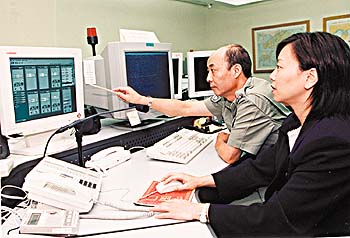New hi-tech Marine communications go live
Digitech: Officers at the hub of the new hi-tech Marine Regional Communication System |
Police airwaves at sea are now clearer than ever thanks to the recent launch of the Voice Sub-System of the new Marine Regional Communication System (MRCS).
Following successful coverage and reliability tests, MRCS went live on October 9 heralding a new era of secure digital communications for the Force.
The second phase of the project, which involves an Automatic Vessel Location (AVL) and Messaging Sub-System, is expected to be ready by early January 2001.
The contract for the current project was awarded to Nokia last October and replaces the Region's Joint Maritime Communications System, operating since 1985.
The new system is based on the open TETRA (TErestrial Trunked RAdio) standard with multi-vendor support. TETRA, originated in Europe in the early 1990s when manufacturers, operators and other experts collaborated in the development of standards to meet the needs of modern emergency services. The standards were built upon the lessons learnt from previous analogue trunked systems and the successful development of GSM networks in the 1980s. The first standards were rolled out in 1995 with the endorsement of the European Telecommunications Standards Institute.
The new radios will have many of the features of a GSM mobile phone, such as text messaging, mobile data and the ability to make and receive calls to and from a public network. Apart from providing clear and secure group communications, TETRA radios can also function as line-of-sight radios (Direct Mode Operation or DMO) when outside the network coverage area. If necessary, network coverage can be easily extended with portable repeaters. As an open standard, additional radios can be sourced from a variety of major manufacturers creating more competition and reducing operation costs.
As part of the AVL and Messaging Sub-System, each major police launch will be equipped with a ruggedised notebook computer interfaced with the radio network. The Sub-System will function similarly to PEN and full integration with the Police Data Network (PDN) will be possible later. Faxing through the TETRA network will also be possible later.
The AVL part of the system will utilise the Global Positioning System (GPS) to give real time position information of launches to the Regional Command and Control Centre (RCCC MAR), operational bases and command launches. Differential GPS signals broadcast by the Marine Department will further enhance position accuracy to within a few metres.
Special electronic map displays have been developed for RCCC MAR to exploit the command and control capabilities of the new system. Control room staff will have a complete overview of real time launch deployments, enhancing effective deployment and efficiency.
The AVL would also record all launch tracks for a period of up to three months for later playback and analysis, providing additional security for sea-going personnel as control room staff can pinpoint their location should they require prompt assistance.
